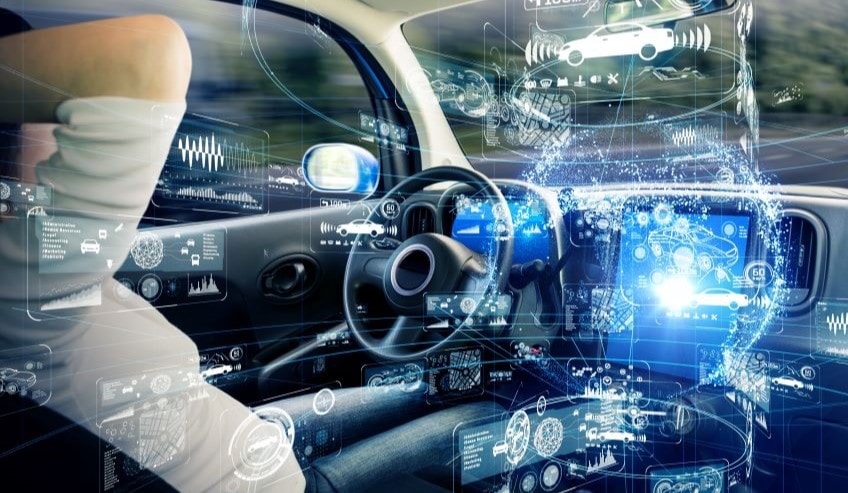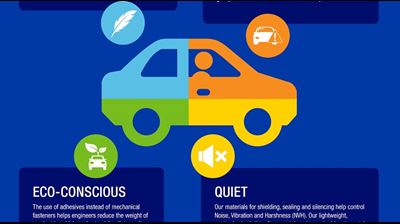
The Glue Talk Blog

Cars of the Future - How Market Trends in Tech, Safety, and Sustainability Will Transform Cars by 2030
Let’s take a road-trip into the future of cars. Are you ready? Sit back and imagine for a moment it’s the year 2030. Rapid advancements in technology continue to transform every major manufacturing industry including automotive, leading to vast improvements in design, safety, and sustainability. Now, try to imagine what a new car in 2030 looks like. Maybe you see an autonomous, futuristic vehicle hovering above the roadway powered by solar energy or a device built into the road itself. Perhaps you see an aerodynamic version of a family-sized sedan that is fully electric and seamlessly integrated with your smartphone.
Cars in 2030 will most likely incorporate aspects of both visions. Since automotive companies, including Volkswagen, Toyota and Ford, were leading global spenders on research and development in 2018, and autonomous and e-mobility pioneers, like CATL and LG, also made large investments, vehicle technology is racing ahead. Using current market trends and projections by leading economists, scientists and engineers, we can form some reasonable predictions about what cars will be like in 10 years.
In the year 2030 …
… AI will make autonomous driving features the new normal
There’s no question that technology is driving the auto market today and will continue to affect car manufacturing and design. Artificial intelligence (AI) and augmented reality technologies are now integral to vehicle concepting and design. By 2030, all new cars are likely to include heads-up display (HUD), voice-activated operating systems, and autonomous driving technologies. HUD technology allows drivers to see information, including environment, navigation and speed, without taking their eyes off the road because they will be displayed digitally on the windshield. This futuristic feature is already being implemented in some new models.
Tech giants, including Google and Apple, are investing millions of dollars to create advanced operating systems (OS) that integrate with smartphones, connect to the internet, and offer autonomous driving features. Apple’s CarPlay OS is already available in current models from Chevrolet, Audi, Honda, and many more. Through voice activation, a driver will be able to control non-basic vehicle functions, like speed, lane changes, braking, navigation, and media functions. It’s estimated that by 2030 most, if not all, new cars will offer self-driving features. This could lead to declines in fuel consumption costs by more than 70 percent. Though cars won’t likely be fully autonomous by 2030, meaning some active driving will still be required, we’ll be one step closer to that inevitable reality.
… Car accidents will be effectively eliminated
Advances in auto technology mean improved safety features in new models. As automakers continue integrating self-driving technologies that include safety features, traffic deaths are expected to drop by 90% by 2030. How will this work? Self-driving technology, if it continues progressing at its current rate, will be far more reliable than human judgment when it comes to operating vehicles on highways or city streets. The common belief is that accidents will be eliminated if/when all vehicles are self-driving. However, there will likely still be accidents when unpredictable humans interact with smart machines.
Features that will be offered by most or all new cars include external airbags, brake assist, frontal collision warning, and driver fatigue detection, as well as intelligent speed assistance, and lane and blind-spot monitoring. For instance, an emergency brake feature paired with a radar-based frontal-collision warning will alert the driver of an anticipated collision and then initiate maximum brake application, faster than any human could, to prevent impact. We can also be certain that the car of 2030 will be not only safer for drivers and passengers, but also the environment.
… Eco-friendly design will transform car design and ownership
Consumer demand for eco-friendly and efficient transportation is increasing rapidly. There’s a global effort by manufacturers to reduce carbon emissions. Alternative fuel development has come into focus in the industry. The governments of the Netherlands, Germany and India have committed to selling only all-electric new vehicles by the year 2030, and other countries, particularly in the EU, are set to follow suit by 2040. The fastest-selling cars of today are already hybrid or electric, including the Tesla Model S, Toyota Prius, and Chevy Volt. By 2030, high-demand car models will be plug-in electric vehicles or hybrids (a combination of electric and gasoline or biodiesel fuel). Solar-powered vehicles, like the new Hyundai Sonata, are the new normal for designers. This shift to eco-friendly energy is projected to reduce road pollution by a staggering 60%, driving down global oil consumption. As battery technology continues to improve, we will see more affordable all-electric cars on the road, capable of maintaining a charge for long-distance trips as well as shorter commutes.
Another eco-friendly trend that is poised to revolutionize the auto market is car-sharing and subscription-based car services. This means a decline in individual car ownership and the use of services like Uber and Lyft as well as Drift, a web-based, peer-to-peer car-sharing service. In 2030, having a car-as-a-service subscription or pay-per-use option will be almost as casual as having a subscription to Netflix (though likely slightly more expensive). However, experts caution that the freedom and flexibility consumers value in car ownership will never go away, even with alternatives available. We can expect cars to be on the road for a long time.
The focus on efficiency extends to design as well. New cars in 2030 are going to be more compact, lighter, and lower to the road to improve aerodynamics. Cars might not be able to sprout wings and fly you away from a traffic jam, but they will be sleeker and more efficient, with an emphasis on customization options. You might even be able to change the exterior or interior color of your car using your smartphone. Sustainable and flexible materials, like plastics and polymer composites, grow steadily more commonplace in car design and manufacturing.
No matter what the car of the future looks like, H.B. Fuller has high-performing automotive adhesive solutions for your needs today and tomorrow. You can trust us to adapt to the latest technology and meet shifting consumer demand. Learn more about our full scope of automotive products.
Click on the image to view Adhesives Address Automotive Trends infographic.
Sources:
https://carsurance.net/blog/automotive-industry-statistics/
https://carsurance.net/blog/future-of-cars/
https://www.thecoolist.com/car-of-the-future-automotive-design/
https://sites.ndtv.com/roadsafety/10-futuristic-car-technologies-make-roads-safer-2790/
Blog Categories
Blog Categories
Archive
- 2024
- 2023
- 2022
-
2021
- January (3)
-
February (7)
- Celebrating Exceptional Service During COVID-19 Complications
- Cyanoacrylates: What They Are and What They Do
- Innovative two-shot bookbinding adhesive
- Make a Difference 2020
- Problem Solving: Paper Straws in Drinking Beverages
- Stronger straws sustainable future
- Substances of Interest in Disposable Absorbent Hygiene Products
- March (4)
- April (4)
- May (4)
- June (5)
- July (2)
- August (5)
- September (2)
- October (1)
- November (3)
- December (2)
-
2020
- January (4)
- February (2)
- March (3)
- April (4)
- May (3)
-
June (7)
- Community Support in the Era of Coronavirus
- HBFuller Employee Creates Face Shields with 3D Printer
- Improved Packaging Integrity and Greater Customer Satisfaction
- Liquid-Resistant Paper Straws
- What is a Sealant?
- What Is the Future of Commercial Disinfectants?
- Winning over consumers with e-commerce packaging solutions
-
July (6)
- Employees Take Action to be Part of Healing and Growth
- Gain a competitive advantage with packaging adhesive solutions
- HB Fuller Company Foundations Commitment to Communities
- Packaging Solutions for the South African Agriculture Market
- Supporting Organizations That Provide STEM Education for Youth
- Where Does Sustainability Stand Amid COVID-19
- August (3)
- September (2)
- October (4)
- November (2)
- December (4)

